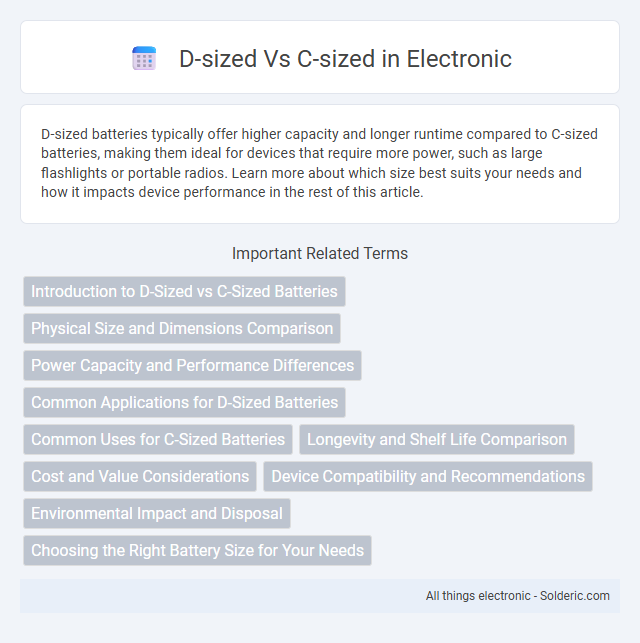D-sized batteries typically offer higher capacity and longer runtime compared to C-sized batteries, making them ideal for devices that require more power, such as large flashlights or portable radios. Learn more about which size best suits your needs and how it impacts device performance in the rest of this article.
Comparison Table
| Feature | D-sized Battery | C-sized Battery |
|---|---|---|
| Dimensions | 61.5 mm length, 33.2 mm diameter | 50 mm length, 26.2 mm diameter |
| Capacity | Approx. 12,000 - 18,000 mAh | Approx. 8,000 - 9,000 mAh |
| Voltage | 1.5V (alkaline) | 1.5V (alkaline) |
| Weight | 140 - 160 grams | 70 - 100 grams |
| Typical Usage | High power devices, flashlights, radios | Medium power devices, toys, portable electronics |
| Price Range | Higher due to size and capacity | Moderate |
Introduction to D-Sized vs C-Sized Batteries
D-sized and C-sized batteries differ primarily in their dimensions and capacity, with D-sized batteries measuring approximately 61.5mm in height and 34.2mm in diameter, offering higher milliampere-hour (mAh) capacity suited for high-drain devices. C-sized batteries, smaller at around 50mm in height and 26.2mm in diameter, provide moderate capacity ideal for medium-drain electronics such as flashlights and toys. Understanding these size and capacity distinctions aids in selecting the appropriate battery type for specific power requirements and device compatibility.
Physical Size and Dimensions Comparison
D-sized batteries typically measure 61.5 mm in length and 34.2 mm in diameter, making them larger and heavier compared to C-sized batteries, which generally measure 50 mm in length and 26.2 mm in diameter. The increased physical size of D batteries allows for a higher capacity, supporting devices that require prolonged power. Choosing between D and C-sized batteries depends on the device's size constraints and power consumption needs.
Power Capacity and Performance Differences
D-sized batteries offer significantly higher power capacity compared to C-sized batteries, typically providing around 12,000 to 18,000 mAh versus C-sized batteries' 8,000 to 9,000 mAh. This increased capacity allows D-sized batteries to deliver longer runtime and better performance in high-drain devices like flashlights and radios. While both sizes maintain similar voltage outputs (1.5V for alkaline), the enhanced energy storage in D-sizes makes them more suited for applications demanding sustained power.
Common Applications for D-Sized Batteries
D-sized batteries are commonly used in high-drain devices such as flashlights, portable radios, and large toys where long-lasting power is essential. They provide greater capacity and longer runtime compared to C-sized batteries, making them ideal for equipment requiring sustained energy output. Popular applications also include camping gear, emergency equipment, and some medical devices.
Common Uses for C-Sized Batteries
C-sized batteries are commonly used in medium-drain devices such as toys, flashlights, and musical instruments, providing a balanced combination of capacity and size. These batteries fit devices that require more power than AA batteries but are too compact for larger D-sized cells. Your choice of C-sized batteries typically ensures efficient energy delivery for portable electronics that need moderate, sustained power.
Longevity and Shelf Life Comparison
D-sized batteries typically offer longer longevity due to their larger capacity, making them ideal for high-drain devices and extended usage. C-sized batteries have a smaller capacity, resulting in a shorter lifespan but are suitable for medium-drain devices with moderate usage demands. Shelf life for both sizes is generally similar, with alkaline versions lasting up to 5-10 years when stored properly in a cool, dry environment.
Cost and Value Considerations
D-sized batteries typically offer a higher capacity and longer runtime compared to C-sized batteries, making them more cost-effective for high-drain devices despite their higher upfront price. C-sized batteries are generally less expensive initially and suitable for moderate power needs, balancing cost and performance for everyday use. Choosing between D-sized and C-sized batteries depends on your device's energy demands and whether long-lasting power or budget-friendly options provide better value.
Device Compatibility and Recommendations
D-sized batteries are commonly used in high-drain devices like flashlights, portable radios, and large toys, providing longer runtime due to their larger capacity. C-sized batteries fit medium-drain devices such as musical instruments, handheld gaming devices, and some medical equipment, offering a balance between size and power output. Device compatibility depends on the battery compartment design and power requirements, making it essential to consult manufacturer recommendations to ensure optimal performance and safety.
Environmental Impact and Disposal
D-sized and C-sized batteries differ in environmental impact largely due to their capacity and usage lifespan; D-sized batteries typically last longer but consume more raw materials, resulting in a greater initial resource footprint. Both types contain hazardous chemicals like mercury, lead, and cadmium, necessitating proper disposal via recycling programs to minimize soil and water contamination risks. Recycling not only reduces harmful waste but also recovers valuable metals, helping conserve natural resources and reduce greenhouse gas emissions.
Choosing the Right Battery Size for Your Needs
Choosing the right battery size, whether D-sized or C-sized, depends on your device's power consumption and runtime requirements. D-sized batteries offer higher capacity and longer life, making them ideal for high-drain devices like flashlights and large toys, while C-sized batteries suit moderate power needs such as in portable radios or small kitchen appliances. Assessing your device's energy demands will help ensure you select the battery that optimally balances performance and longevity for Your needs.
D-sized vs C-sized Infographic

 solderic.com
solderic.com